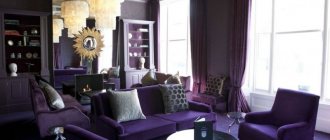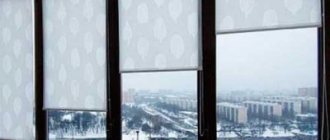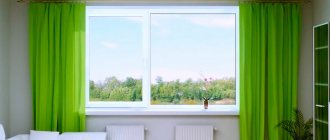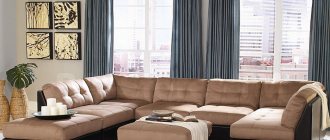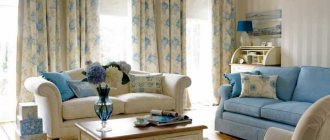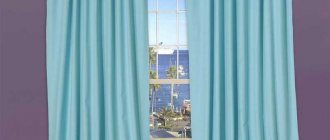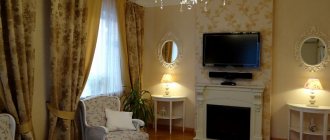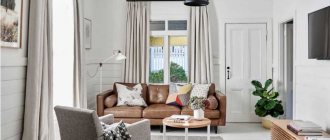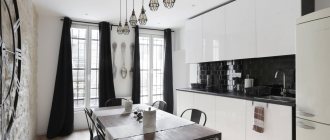Practicality, functionality and attractiveness - these are the main requirements for modern window textiles. Roman blinds are endowed with all these qualities. They have a laconic appearance and at the same time attract attention, are easy to use, easy to maintain and can be used for fabric decoration of any window openings, including arched, bay windows and triangular. Roman blinds for plastic windows are presented in a large assortment, and everyone can choose a model based on the functionality of the room and its design.
Advantages and disadvantages
Roman window models, despite their simple design, always look interesting.
They are appropriate in any interior, combine perfectly with other types of curtains and create amazing compositions, bringing comfort and harmony to the atmosphere of the room.
Other advantages:
- stylish design;
- variety of colors;
- ease of operation and maintenance;
- space saving;
- good sun protection;
- Can be used in any room;
- affordable price.
The main disadvantage is the difficult functioning of a window with a window: to open it, the panel must be lifted each time.
Interesting facts about Roman blinds
- You can quickly clean them from dust using a regular vacuum cleaner. There will be no old dust or small specks.
- If there are several narrow windows on the wall, it is possible to install one design for them.
- Sometimes washing can be replaced by cleaning. Simply treat the fabric with a suitable cleaning agent.
- For a long time, Roman blinds have enjoyed continued popularity among consumers and designers. Their properties and excellent qualities are suitable for most premises and living rooms. They fit best into most interiors, serve as additional decoration and at the same time perform a particularly important role - they regulate lighting or close windows tightly.
Types of curtains
Based on their design features, there are 4 types of Roman-style lifting curtains:
- frame;
- frameless;
- cascade;
- double.
The first type is the classic option. When lifted, the canvas forms even folds due to rigid transverse strips. In the second case, there are no strips, so the formed folds sag. The third type is different in that the textile product retains its drapery even when open, because it is made with an overlap.
And the last option is two-layer models that create a “day-night” effect. One of their fabrics is dense, it serves to protect from sunlight, the other is light and airy.
You can control the raising/lowering of the canvas manually (with a cord) or automatically (with a remote control).
According to density, curtains are divided into:
- transparent, transmitting light well;
- translucent, softly scattering sunlight;
- dense, providing maximum sun protection.
Roman blinds and their features
This type of curtain is made from an even cut of fabric secured to several transverse strips. Thanks to them, when the curtains are raised, the textiles gather into even folds, reminiscent of a cascade. Most products are equipped with a special mechanism that regulates the level of light in the room.
Features of Roman blinds:
- strictly rectangular shape of the canvas;
- uniform arrangement of pockets with fixed strips along the entire length of the curtains;
- manufacturing guides from soft or hard materials (the severity of the folds depends on their rigidity);
- a strip of plastic or metal attached to the bottom edge of the product (provides uniform tension of the fabric).
Thanks to their simple and convenient design, curtains of this type are used in such modern design trends as high-tech, minimalism, and modern. In classical styles, pure Romanesque curtains are rare: more often they are part of the composition in combination with tulle, lambrequin and classic straight-cut curtains.
Material selection
Initially, Roman blinds were made only from natural fabrics.
The modern window textile market offers products from the following fabrics:
- natural (cotton, linen, matting, wool, burlap);
- synthetic (organza, veil, taffeta, mesh);
- mixed (jacquard, artificial velvet and silk).
What are the benefits of Roman blinds?
- 1Effective and versatile curtains have earned enormous popularity for a reason. They are used to decorate houses, apartments, offices, restaurants, hotels and many other premises. Roman blinds have many undeniable advantages:
- 2Aesthetics. They can be used as a separate window decoration item, but the option of combining them with classic curtains is not excluded. Harmoniously fitting into the overall interior, they create an atmosphere of warmth and comfort.
- 3Functionality. They can be an original piece of furniture for window decoration, but, at the same time, play an important role in shading the room from bright light. Depending on the fabric chosen for them, various design tasks are solved.
- 4Variety. There are so many fabrics in the world with their variety of colors, textures, finishes - so many options for Roman blinds can be made using them. It all depends on your imagination.
- 5Efficiency. To make such curtains, an optimal amount of material is required, calculated for a specific room.
- 6Easy to care for. The panels are attached to the cornice using convenient Velcro. They can be easily removed and washed. Even light-colored or delicate fabrics will remain clean and fresh for a long time because they are not exposed to frequent hand contact.
Sizes and colors
Roman style curtains can be floor length, cover the window sill and not reach it. Short products save space, while long ones hide the entire opening. The maximum size of the lift curtain is 3x3.
The colors of the canvases are very different. Beige and brown are popular. Calm, warm shades create a pleasant and homely atmosphere. However, other colors are no less popular, including expressive black and attractive red. For example, red curtains will fit organically into the interior if the color has a pair - a red tabletop or lampshade. And the black textiles on the panoramic window attract the eye and indicate the extraordinary taste of the owner of the room.
Roman window models often have surrounds. Wide or narrow, matching or contrasting colors, located along the perimeter or just along the edges, it changes the visual perception of window textiles and focuses attention on it. Another technique of color decor is a vertical stripe in the center of the curtain to match the edging.
Designs on fabrics – geometric, floral, patterned.
An interesting option are curtains with photo printing, which add uniqueness to the interior.
The curtains are decorated with fringe, tassels, bows and additional drapery on top of the canvas.
Bedroom
This room offers an increased level of comfort, peace and coziness. The bedroom window and balcony door can also be decorated with Roman blinds. Dense, long, heavy panels, although they add a feeling of intimacy, at the same time bring a lot of troubles associated with the elimination of dust accumulations.
The Roman blind for the balcony door in the photo, made of dense material and used instead of heavy floor-length panels, will help maintain comfortable, dim lighting in the bedroom. Velvet or tapestry fabric is suitable as a material. You can also combine several options when the window is decorated in a traditional way, and the balcony door is decorated with classic or cascading models, as in the photo. It is better to choose a warm, slightly muted color. However, if the bedroom interior allows this, some designers offer steel or black options.
Thus, when decorating a window and balcony door with Roman blinds in the kitchen, living room or bedroom, you should adhere to the main criterion - a combination of attractiveness, functionality and convenience. Only then can you get not just protection from excessive sun rays and neighborly curiosity, but also a worthy functional decoration of the interior.
Mounting options depending on the design of the plastic window
Attaching curtains to plastic windows is just as easy as to attaching them to wooden ones. The most common method is “Velcro” - a special tape, one part of which is attached to the fabric, the other is built into the cornice.
Other types of fastening: loops, eyelets, rings, braid, ties, belts. Textiles with loops look laconic and strict, while those with bow ties look fun and flirty.
Depending on the design of the window, curtains are installed:
- on the sash;
- on the top of the frame;
- on the wall;
- on the ceiling.
Models located on the sashes of plastic windows do not interfere with their opening. Fastening to the frame ensures a tight fit of the canvas and provides free access to the window sill. If the cornice is mounted on the wall, you can visually enlarge a small window and hide the imperfections of the wall and window opening. Ceiling mount is more suitable for wide and voluminous curtains.
Frame curtains can be used to decorate any type of window. The beautiful geometry of the folds will add originality to even a non-standard opening.
Arched
Velcro models are used for arched openings. They make the perception of the window light and harmonious. The shape of the cornice is straight or follows the curve of the arch.
Attic
Laconic and practical Roman models will be an excellent design for roof windows.
Oblique
To ensure that the textiles do not hang from the inclined window, but fit tightly to the glass, curtains with side guides are used.
Panoramic
Lifting curtains for panoramic windows are mounted on the wall. When unfolded, they mask the size of large glazing, and when assembled, they emphasize the size of the windows.
Beveled
Roman models can be installed on sloping openings, but the window cannot be fully opened. The task of lifting curtains that repeat the shape of the bevel is to emphasize the original shape of the opening and emphasize its contour. The cornice for slanting windows should duplicate the geometry of the ceiling.
Curtains on triangular openings are hung on 2 slats located at an angle, and the curtain is lifted to the breaking point.
Triples
Decorating a three-leaf opening with Roman or roller blinds is used in various styles. Fabric curtains installed on each sash allow you to partially darken the window and emphasize its exclusive appearance.
Corner
It is better to hang a simple shortened model on a corner window. If the side is sunny, choose thick fabric. Otherwise, the windows are decorated with transparent textiles.
Bay windows
Roman curtains are the best option for decorating bay windows of any shape. They are attached to a window opening, and such curtains look aristocratic and sophisticated.
Material for making canvases
Among all the diversity, there are several main materials used for sewing:
- Linen. Natural hypoallergenic material that looks great in any interior. Ideal for the bedroom and living room, but should not be used in the kitchen, as it absorbs odors, and should only be washed in a certain cycle. The material should be dried carefully, as the resulting wrinkles are unlikely to be ironed.
Linen option in a wooden house
- Cotton. Natural and budget option. It creates an atmosphere of homeliness and comfort. Often used in children's rooms and bedrooms. You should also not hang cotton curtains in the kitchen, since in addition to absorbing odors, frequent washing causes the fabric to become thinner.
Cotton model
- Synthetics. Perfect for the kitchen. Such fabrics are often additionally treated with special solutions that repel dirt.
Bright synthetics
- Mixed fabrics. The golden mean between the ease of care of synthetics and the naturalness of the fabric.
Modern mixed version
Choose the appropriate option, and Roman blinds for plastic windows will be the perfect finishing touch to your room’s decor.
Roman curtains in the interior of rooms and style
Roman style curtains are universal. They are used in any room of the house. They are great for bringing to life many original projects and designs, especially Scandinavian ones, where Roman models lead the ranking of textile window decorations.
To the living room
Curtains chosen to match the overall color scheme or in contrast with it will help to emphasize the uniqueness of the design. The figured bottom of the canvas will make the interior more stylish and expressive. Canvases with gold monograms and damask patterns look good in the living room.
To the bedroom
This is a place designed for relaxation and privacy. Openwork Roman products combined with a thick curtain, which, if necessary, will protect from the sun and prying eyes, will help create a cozy and comfortable environment.
To the nursery
Both bright and calm models are used here, depending on the atmosphere created in the room. Curtains made from natural fabrics can repeat the wallpaper pattern or be in the same tone. Shortened canvases with a pattern are often combined with white blinds or transparent curtains.
To the office
The neat design of the curtains emphasizes the rigor of the office and sets the mood for work.
To the kitchen
Short curtains are suitable for kitchen design because they free up the window sill, are less dirty and at the same time look attractive and cozy. You should choose synthetic and mixed fabrics that are more wear-resistant, do not absorb odors and are easy to wash.
A window in a white kitchen can be decorated with transparent white textiles with a wide green border. Lovers of sunny shades will love the option of combining brown-honey textiles and long yellow muslin with tie-backs. In a Scandinavian-style kitchen, green curtains to match the curtains or the highlighted wall are appropriate.
To the loggia and balcony
With the help of Roman blinds you can improve the ergonomics of a balcony or loggia. They do not steal free space, but open it up as much as possible.
To the stairwell
Textile decoration of windows on the stairs in a country house poses some difficulties. This is due to the fact that they are either multi-level or high and narrow. If the opening height is 400 cm, the lifting mechanism may not be able to withstand the load. Therefore, windows on a flight of stairs are often divided into parts. The upper one is made stationary, and the lower one is made lifting.
Interior style
It is important to consider the overall design of the room. In a rustic style, orange Roman blinds and snow-white tulle will look impressive. If Provence is chosen, romantic floral models decorated with ribbons and lace edging are suitable. In a brutal loft, strict plain curtains are hung on a large window. Against the background of red brick walls, curtains of muted brown or powdery color look good. For a Scandinavian interior, it is better to choose shortened models that match the color of the sofa upholstery or other textiles in the room.
Mounting methods
Roman blinds are attached to windows using certain mechanisms. They vary depending on the requirements and the shape of the opening:
- Mini cornice. A special device allows you to attach the curtain directly to the window frame. This option is suitable for rooms with a small area, as it allows you to leave the window sill free and allocate space for placing a decorative group or vases of flowers.
- Classic cornice. They are used to install large curtains; they are mounted on the wall above the opening.
- Complex type cornice. This device is used when decorating windows with a beveled or arched upper part.
Curtain rods can be based on mechanisms with electric lifting of the canvas or manual lifting.
Criterias of choice
To find your version of a Roman blind, you need to answer the following questions:
- What is the purpose of the room and what design is it decorated in?
- How strong is the intensity of sunlight entering the room through the window?
- What is the size, shape of the window opening and how does it open.
Next, determine the shape, size and density of the curtains. Then they move on to choosing colors. It depends on the main color palette of the room and personal preferences.
How to choose the right Roman blinds
The main thing to consider when choosing curtains is the size of the window openings . To do this, you can measure the size of the window and purchase canvases of exactly the same size.
You also need to pay attention to the method of fastening - as a rule, the fastening mechanism is simple and is a regular cornice. Curtains are usually mounted on a profile made of metal, plastic or wood (aluminium, PVC or natural wood).
Important: the size of the curtain rod must correspond to the size of the curtains.
You also need to remember some recommendations on how to choose fabric for Roman blinds - so that you don’t regret your choice later.
The history of Roman blinds
These comfortable and beautiful curtains in an unusual design appeared approximately 2000 years ago. Since ancient times, the appearance of Roman blinds has remained virtually unchanged.
There are several legends or versions of how and where Greek curtains (Roman curtains) came to us. Researchers have still not agreed on which of the stories is the most truthful, since all the assumptions look convincing.
According to one version, it is believed that these beautiful canvases, which we now see in the interiors of houses, were used as thick sails on military ships in Ancient Rome. One of the sailors decided to use the sails as curtains. His neighbors liked his idea, and soon the unusual use of the sail became widespread throughout Rome.
According to another legend, Roman curtains originated from the famous spectacles of antiquity - gladiatorial fights in the Colosseum. Huge awnings were used to protect from the scorching rays of the sun. After completing the competition, they were collected in folds and pulled together with strong, thick ropes. One of the enterprising spectators somehow picked up this idea and began to use a similar design in his home.
Many historians are convinced that the design of rims with a lifting mechanism was invented by women in Ancient Rome. Housewives, trying to create a cozy atmosphere in their homes, moistened ordinary curtains with water. Thus, they tried to escape from the sweltering heat. Also, wet curtains became a barrier to dust coming from the street. The soaked cloth was heavy, and lifting it up was very difficult for fragile representatives of the fairer sex. Then the inventors came up with curtain ties and, using this convenient system, easily coped with the collection of wet fabric on the windows.
